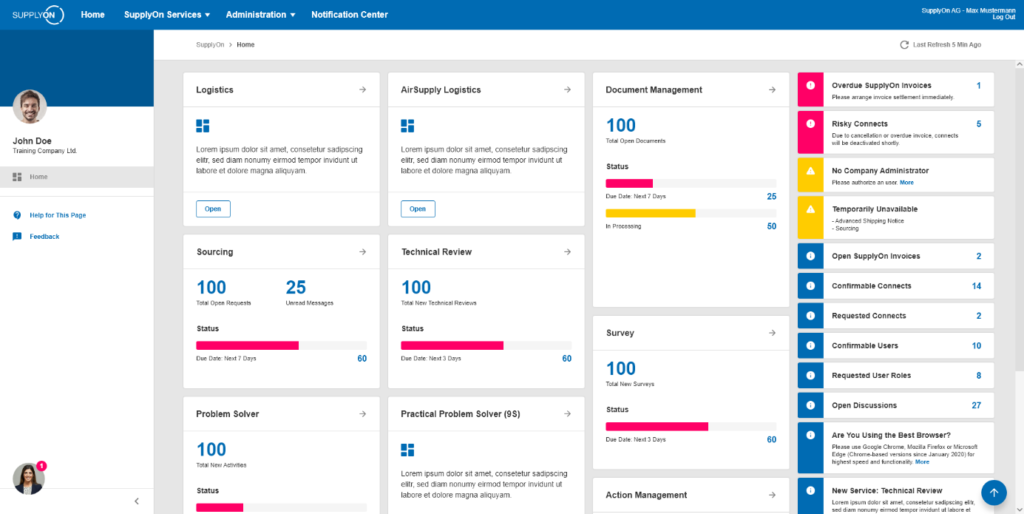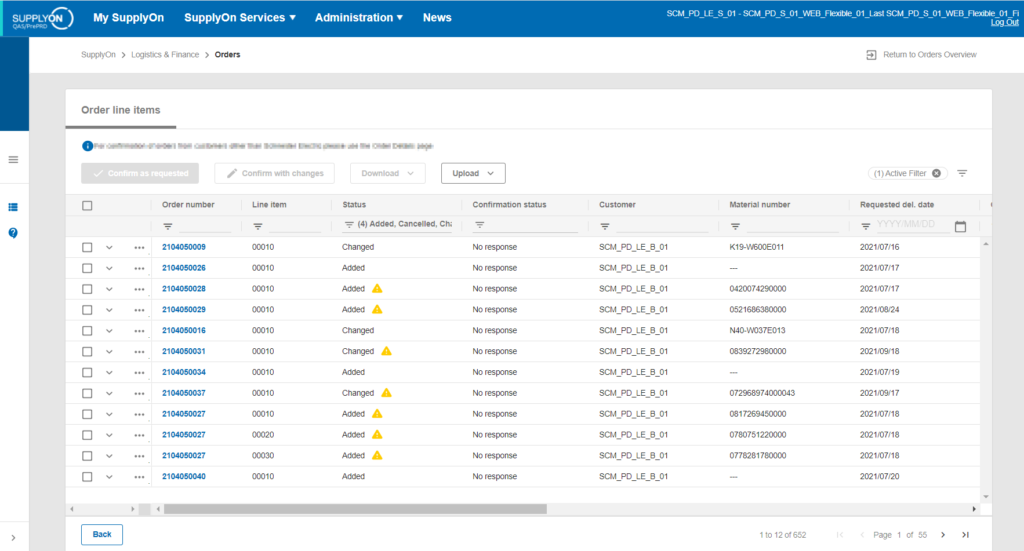Program Increment (PI) 2021-01: Find out what has been developed at SupplyOn in the last quarter

In 2021, we are celebrating two anniversaries at a time: two years of agile software development via SAFe and one year of virtual PI planning. Since 2019, we have been reviewing the progress achieved in our solutions every three months in large rounds of so-called Program Increments (PI) – and for the past year, we have been following the innovations in virtual PI Plannings remotely. Nevertheless, it is always exciting to see what new functions and features have been developed.
What have the development teams already successfully implemented this year?
Visibility & Analytics
In the area of Visibility & Analytics, the developers have done a great job by driving three exciting topics forward:
- Two of our customers can now enjoy the new “Transport Control Tower” dashboard. It is linked to the respective transport system of the customers. Customer-specific data is processed and displayed together with data from SupplyOn. In the Transport Control Tower, users can keep an eye on all transport-related processes in one place and identify potential risks at an early stage. Data on FPAs, ASNs, due dates, transport company performance, OTD performance, as well as plant and other status information are graphically processed and provide a quick overview.
- Additionally, with the upcoming productive release, there are some additions to the Visibility & Analytics portal application.
- Frequently requested, now successfully implemented: The bookmark function. In the future, users no longer have to set all the necessary filters after each login until they can create a specific report. To save time, they can bookmark the filter settings and conveniently refer back to them the next time.
- Many customers will be happy to find the subscription feature implemented. This allows the users to have reports sent to them automatically by e-mail without having to log in to the platform and download them. Here, users can specify the format, timing and frequency of the e-mail generation with the desired report and have it conveniently sent to them at the desired time.
- With the new upload functionality, another channel for integrating report data has been created. This allows necessary data for reports to be made available in a simple and intuitive way.
- And last but not least, we are pleased to present the first SupplyOn mobile app. With the same roles and permissions as on the desktop, users will be able to access and download our reports on mobile devices in the future. We support iOS and Android systems.
Portal
In the Portal area, users will soon be able to navigate even faster to their destination. Within the next few weeks, the starting page will be replaced by the dashboard accessible under “My SupplyOn”.
The SupplyOn Dashboard provides an overview of the most important business transactions, that can be accessed directly with one click. For example, RFQs that are still open or due shortly, or critical projects are displayed. In addition, the dashboard informs users with administrative roles about important tasks that need to be completed (for instance, the approval of additional permissions).

Supplier Quality Management
From now on, the Technical Review solution for feasibility studies can also be used together with the Sourcing solution. Previously, usage was tied to the Project Management solution. As a result, customers can now access Technical Review directly in the sourcing process to perform a component-based query.
Supply Chain Management
In the SCM area, an overview of purchase order items has been added in addition to an overview of individual purchase orders. This enables suppliers to gain quick insights into the order data at item level. They can also process purchase order items directly in the list – even across different purchase orders – in a quick and structured manner and confirm them to the customer.

Transport Management
The Transport Management System (TMS) now offers an interface to the billing portal. With the help of this billing portal, the dispatcher queries the costs for the assembled transport early in the transport management process. This happens on the basis of rules stored in the TMS and rates in the settlement portal. Based on the early cost indication, the most cost-effective carrier can be selected.
In addition to the billing portal module, dock/slot management has also been integrated into the transport management system. If loads are transported via a transshipment point such as a warehouse, this can be managed with the help of this feature. If a booking at a warehouse is required for a commissioned load, the forwarder now has the option to book a ramp at said warehouse. This can minimize waiting and downtime for the forwarder. The operator of the warehouse can also plan more efficiently.
As an additional functional enhancement, customers will in future be able to define the carrier’s route in the system. As soon as there are shipments in the system that are on the way, a load – from the affected shipments – is automatically compiled for this route in the transport management system. The cost factor plays a major role here. For example, a route starts at a specific customer plant and makes its way via various suppliers with loads or unloads to the next customer plant. Thus, new packages such as pallets are loaded or unloaded along the way.
In addition to this, there is now also the display of the load between the stops (loading or unloading) of this route. This allows the dispatcher to optimize loads based on the selection of a vehicle type.
Invoicing
In the Invoicing area, invoices previously had to match exactly the specifications of the existing purchase order in almost every detail. Otherwise, the invoice was rejected and had to be corrected manually (for example, in the case of incorrect or missing item numbers). However, these were often only technical or minimal deviations.
SupplyOn Invoicing now takes action at this point and uses Artificial Intelligence to automatically assign incomplete or incorrect data correctly, complete it and revise it if necessary. This effectively prevents unnecessary rejection of the document. Thus, there are significantly lower processing costs for the customer. After all, more invoices can be automatically posted without any queries.
There is another innovation in the area of invoicing:
Many suppliers use further input channels for invoicing in addition to the web-interface (for example, EDIFACT or Excel/CSV). When processing these invoices, validation errors can occur from time to time, which must be corrected by the supplier.
SupplyOn is now starting to make this rework easier for the supplier. Depending on his workflows, new possibilities arise.
- On the one hand, he can filter any error messages and download them as a CSV file. This makes it easier for him to organize the necessary postprocessing in other tools (for example, his ERP system or in Excel).
- On the other hand, he can also rework incorrect documents directly via the graphical user interface and send them again. The supplier can do this comfortably without having to export data beforehand.
Supplier Management
There have also been new innovations on the supplier side in recent months. In the Flexible Survey solution, until now only Buyside customers could create surveys to query supplier data or current information such as the Covid 19 situation in a targeted and efficient way. Together with a customer, the supplier management team has now extended the solution with ” supplier-initiated surveys”. This significantly expands the suppliers’ scope of action. They can now independently start a communication process defined by the customer. From now on, the data they send to their customer can be tracked holistically and is fully integrated on a single platform.
In the first use case, suppliers create change requests for delivered products. The questionnaire contains all the necessary information allowing the customer to easily accept or reject the request. Further use cases will follow to achieve the goal of 100% communication and collaboration via SupplyOn.
Over the past three months, our development teams have accomplished a lot. Stay tuned and find out what happens next as there’s always the next PI coming up.



